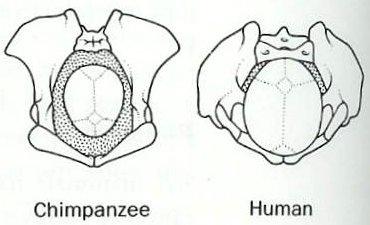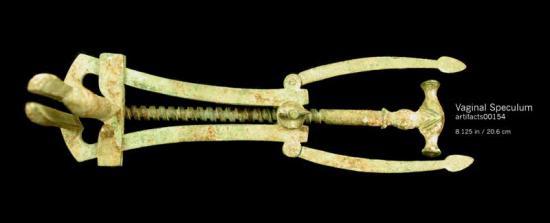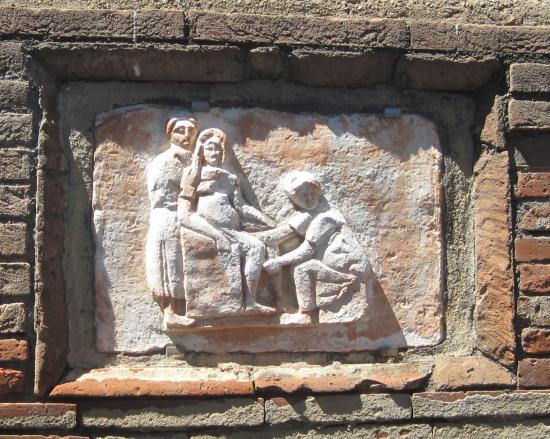Kristina Killgrove
Source - http://www.poweredbyosteons.org/2012/03/childbirth-and-c-sections-in.html
Basically since we started walking upright, childbirth has been difficult for women. Evolution selected for larger and larger brains in our hominin ancestors such that today our newborns have heads roughly 102% the size of the mother's pelvic inlet width (Rosenberg 1992). Yes, you read that right. Our babies' heads are actually two percent larger than our skeletal anatomy.
 |
|
Fetal head and mother's pelvic inlet width - Photo credit: Evolution-of-man.info
|
Obviously, we've also evolved ways to get those babies out. Biologically, towards the end of pregnancy, a hormone is released that weakens the cartilage of the pelvic joints, allowing the bones to spread; and the fetus itself goes through a complicated movement to make its way down the pelvic canal, with its skull bones eventually sliding around and overlapping to get through the pelvis. Culturally, we have another way to deliver these large babies: the so-called caesarean section.
Up until the 20th century, childbirth was dangerous. Even today, in some less developed countries, roughly 1 maternal death occurs for every 100 live births, most of those related to obstructed labor or hemorrhage (WHO Fact Sheet 2010). If we project these figures back into the past, millions of women must have died during or just after childbirth over the last several millennia. You would think, then, that the discovery of childbirth-related burial - that is, of a woman with a fetal skeleton within her pelvis - would be common in the archaeological record. It's not.
Archaeological Evidence of Death in Childbirth
Two recent articles in the International Journal of Osteoarchaeology start the exact same way, by explaining that "despite this general acceptance of the vulnerability of young females in the past, there are very few cases of pregnant woman (sic) reported from archaeological contexts" (Willis & Oxenham, In Press) and "archaeological evidence for such causes of death is scarce and therefore unlikely to reflect the high incidence of mortality during and after labour" (Cruz & Codinha 2010:491).
The examples of burials of pregnant women that tend to get cited include two from Britain (both published in the 1970s), four from Scandinavia (published in the 1970s and 1980s), three from North America (published in the 1980s), one from Australia (1980s), one from Israel (1990s), six from Spain (1990s and 2000s), one from Portugal (2010), and one from Vietnam (2011) (most of these are cited in Willis & Oxenham). Additionally, I found some unpublished reports: a skeleton from Egypt, a body from the Yorkshire Wolds in England, and a skeleton from England.
The images of these burials are impressive: even more than child skeletons, these tableaux are pathos-triggering, they're snapshots of two lives cut short because of an evolutionary trade-off. The wide range of dates and geographical areas illustrated in the slideshow demonstrates quite clearly that death of the mother-fetus dyad is a biological consequence of being human. But what we have from archaeological excavations is still fewer than two dozen examples of possible childbirth-related deaths from all of human history.
Where are all the mother-fetus burials?
As with any bioarchaeological question, there are a number of reasons that we may or may not find evidence of practices we know to have existed in the past. Some key issues at play in recovering evidence of death in childbirth include:
- Archaeological Theory and Methodology. From the dates of discovery of maternal-fetal death cited above, it's obvious that these examples weren't discovered until the 1970s. Why the 70s? It could be that the rise of feminist archaeology focused new attention on the graves of females, with archaeologists realizing the possibility that they would find maternal-fetal burials. Or it could be that the methods employed got better around this time: archaeologists began to sift dirt with smaller mesh screens and float it for small particles like seeds and fetal bones.
- Death at Different Times. Although some women surely perished in the middle of childbirth, along with a fetus that was obstructed, in many cases delivery likely occurred, after which the mother, fetus, or both died. In modern medical literature, there are direct maternal deaths (complications of pregnancy, delivery, or recovery) and indirect maternal deaths (pregnancy-related death of a woman with preexisting or newly arisen health problems) recorded up to about 42 days postpartum. An infection related to delivery or severe postpartum hemorraging could easily have killed a woman in antiquity, leaving a viable newborn. Similarly, newborns can develop infections and other conditions once outside the womb, and infant mortality was high in preindustrial societies. With a difference between the time of death of the mother and child, a bioarchaeologist can't say for sure that these deaths were related to childbirth. Even finding a female skeleton with a fetal skeleton inside it is not always a clear example, as there are forensic cases of coffin birth or postmortem fetal extrusion, when the non-viable fetus is spontaneously delivered after the death of the mother.
- Cultural Practices. Another condition of being human is the ability to modify and mediate our biology through culture. So the final possibility for the lack of mother-fetus burials is a specific society's cultural practices in terms of childbirth and burial. In the case of complicated childbirth (called dystocia in the medical literature), this is done through caesarean section (or C-section), a surgical procedure that dates back at least to the origins of ancient Rome.
Cultural Interventions in Childbirth
It's often assumed that the term caesarean/cesarean section comes from the manner of birth of Julius Caesar, but it seems that the Roman author Pliny may have just made this up. The written record of the surgical practice originated as the Lex Regia (royal law) with the second king of Rome, Numa Pompilius (c. 700 BC), and was renamed the Lex Caesarea (imperial law) during the Empire. The law is passed down through Justinian's Digest (11.8.2) and reads: Negat lex regia mulierem, quae praegnas mortua sit, humari, antequam partus ei excidatur: qui contra fecerit, spem animantis cum gravida peremisse videtur. (The royal law forbids burying a woman who died pregnant until her offspring has been excised from her; anyone who does otherwise is seen to have killed the hope of the offspring with the pregnant woman.).
 |
|
Example of Roman gynaecological equipment: speculum . From the House of the Surgeon, Pompeii (1st c AD) Photo credit: UVa Health Sciences Library
|
There's discussion as to whether this law was instituted for religious reasons or for the more practical reason of increasing the population of tax-paying citizens. In spite of this law, though, there isn't much historical evidence of people being born by C-section. Many articles claim the earliest attested C-section as having produced Gorgias, an orator from Sicily, in 508 BC (e.g., Boley 1991), but Gorgias wasn't actually born until 485 BC and I couldn't find a confirmatory source for this claim. Pliny, however, noted that Scipio Africanus, a celebrated Roman general in the Second Punic War, was born by C-section (Historia Naturalis VII.7); if this fact is correct, the earliest confirmation that the surgery could produce viable offspring dates to 236 BC.
This practice in the Roman world is not the same as our contemporary idea of C-section. That is, the mother was not expected to survive and, in fact, most of the C-sections in Roman times were likely carried out following the death of the mother. Until about the 1500s, when the French physician François Rousset broke with tradition and advocated performing C-sections on living women, the procedure was performed only as a last-ditch effort to save the neonate. Some women definitely survived C-sections from the 16th to 19th centuries, but it was still a risky procedure that could easily lead to complications like endometritis or other infection. Following advances in antibiotics around 1940, though, C-sections became more common because, most importantly, they were much more survivable.
Caesarean Sections and Roman Burials
 |
|
Roman relief showing a birthing scene - Tomb of a Midwife (Tomb 100), Isola Sacra - Photo credit: magistrahf on Flickr
|
PART. 2